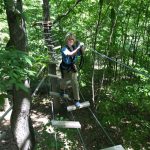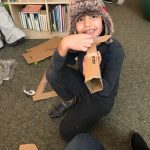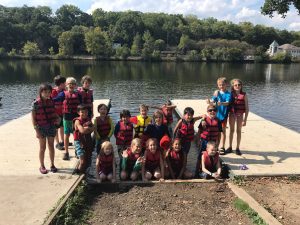Today the students returned to Tree Runner Park in West Bloomfield for an end-of-year climb. It was a beautiful day filled with sun and mild temperatures. One special thing about the park and a reason why we return is the opportunity it offers for students to confront their fears and challenge themselves to go beyond what they previously thought themselves capable of. It was also wonderful to see the ways they supported each other as they climbed, swung and balanced their ways through the courses.
The Story of an Egg . Chickens
This week we took a closer look at the marketing terminology related to poultry welfare and the ways in which terms like, “Cage-free” and “Free-range” can be used by factory farms to mislead consumers.
We also began researching chicken breeds in an effort to determine which would be most suitable for our school. The students reviewed various charts that indicated chicken breeds that would do well in cold climates, provide a healthy amount of eggs, had friendly dispositions and were hardy and forgiving enough towards their novice caretakers. After finding ones that matched the criteria, they started drafts of posters, including illustrations of their chickens and information about the breeds.
The Last Readers . The Little Prince

This week the students were introduced to The Last Readers, an interactive graphic novel that focuses on close reading skills. Throughout the adventure, students are introduced to and practice concepts that encourage a deeper interaction with texts. These include word choice, sentence and narrative structure, point of view, argument and figurative language. The topic for this week was arguments and their structure. In order to broadcast a message of hope to their fellow citizens in the Dome, students had to learn about the relationships between claims, evidence and reasons in an argument. They used these categories to identify parts of an argument, evaluated the quality of arguments and began making their own.
We also continued to work on our production of The Little Prince. The students were challenged to perform their first run on Friday morning. The shortened time frame was by design. Throughout the sessions, students created props and shared observations about things that needed to be considered while they worked. These included the need for a way of sharing and knowing what each student was working on, the absence of a script, and the importance of scale and perspective. While we could have discussed all of these directly prior to beginning, this approach encouraged greater engagement and student self-direction.
Pickled Tomatoes . Garden . Interland . Water . Code
Compost . The Adventure Park
This week, we spent time studying compost, how it’s made and how it benefits the soil and the environment. The students looked at articles and an animation and drafted responses to questions, focusing on complete sentences and domain-specific vocabulary.
Lake Erie . Crafting Excellence . Compost
This week the class traveled to the Lake Erie Metropark Marina to study Lake Erie, the body of water that the Huron River empties into. When we think about the health of our water it’s important to think about the bodies of water and communities both up river and down river from us.
Argo Cascades . The Water Cycle . Great Lakes . Pascal’s Triangle
We began the week on the Huron River, specifically the Argo Cascades. The class, along with extra chaperones (Thanks, Dan and Jenna!) rented tubes and enjoyed a gorgeous day in the sun. For many, it was their first experience there and most left adamant about bringing their families back. In the coming weeks, we will be looking into the history of the cascades and how economic and environmental concerns inform land use decisions. The trip was a joyous one as well and was designed with the hope of building positive connections between the students and the river. This will make our work with the river more meaningful beyond an abstract appreciation.
Identity . Water . The Little Prince . Mathematical Reasoning
This week we worked on writing prompts as a way to connect with aspects of our identity and what matters to us. They included creating a list of rules for being us at this age, describing moments when we were happiest and imagining our lives as a video game and ascribing points to the things that bring us joy, whether that was based on experiences or overcoming obstacles. We will channel these into our work on our 6 Word Memoirs.
- Oceans
- Ice Caps and Glaciers
- Groundwater
- Rivers, Lakes and Streams
- The Atmosphere
- Reporter – Summarizing
- Profiler – Character Analysis
- Curator – Finding Interesting or Confusing Words or Phrases
- Detective – Asking Questions and Making Connections
Conflict Resolution . 6 Word Memoirs . The Little Prince . Visual Thinking in Mathematics
We also thought about the importance of visual representations in math using a series of patterns that represented the numbers 1 – 28. Students identified the numbers and then made connections between numbers through repetitions of patterns in numbers. They also did a gallery walk, observing the connections others made based on how they marked up their work. This activity is good for reinforcing the visual aspect of mathematical thinking as well as an introduction into factors and multiples which they will work on in greater depth later on.
Our First Week Back
Happy First Week of School! This week we spent time settling in and getting to know each other and our space. We began with a game called The Great Wind Blows which helped us learn more about our interests. Academically speaking, the students have been reading independently daily while I conducted informal reading assessments.
Academically speaking, the students have been reading independently daily while I conducted informal reading assessments.










































































































































